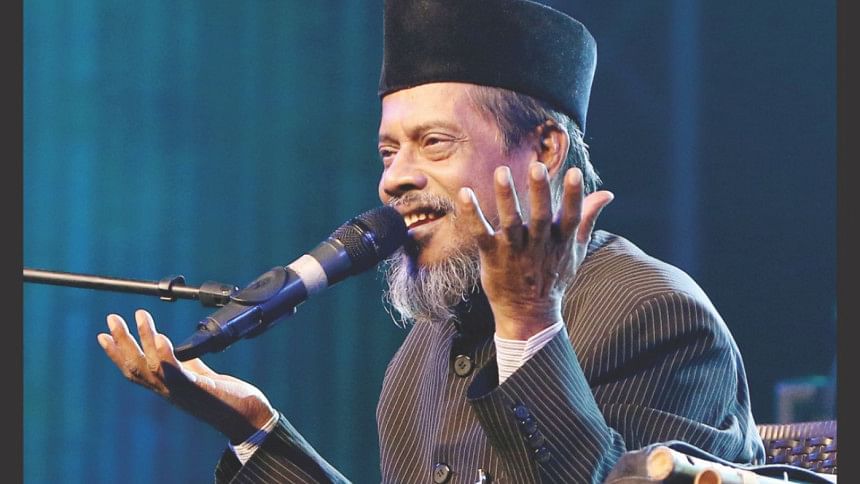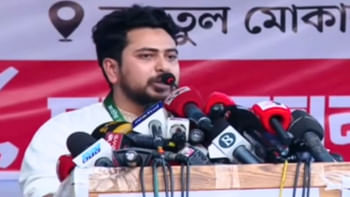The exit of a flautist and folk legend

Eminent folk singer and flautist Bari Siddiqui passed away around 2am on November 24 at the capital's Square Hospital. He was 63. Following his Namaz-e-Janaza at Dhaka University's Central Mosque and his workplace Bangladesh Television, he was laid to eternal rest at his birthplace in Netrokona after Asr prayers yesterday.
During his illustrious music career, the folk legend lent his voice to many popular folk songs. His recorded songs like “Suachan Pakhi Ami Dakitachhi Tumi Ghumaichho Naki”, “Ami Ekta Jinda Laash” and “Maa Go Maa Ji Go Ji” are extremely popular far and wide. He has many albums including “Oporadhi Hoileo Ami Tor”, “Dukkho Roilo Mon-e” and “Matir Deho”, “Matir Malikana”, “Bhalobashar Boshotbari”, “Poraner Pakhi”, “Bhadro Masher Purnima”, “Antor Jwala”, “Andhare Khunji Tomaye”, “Chandro Debi”, “Lokhkho Tara”, “Sorola” and “Dukkho Dile Dukkho Pabi” to his credit.
Years ago, the artiste in an exclusive interview with The Daily Star shared many aspects of his life and his own world of music. Following is the story of the mystic folk bard:
Bari Siddiqui's love for the flute began at the age of five when his elder brother returned home from the weekly haat with a small banshi. Little did he know that one day, he would be recognised as an eminent musician across the country. In fact, Bari's reputation extends beyond Bangladesh; he has performed and conducted workshops in France, Switzerland, Malaysia, Pakistan, Iran and Singapore.
Bari Siddiqui comes from a family of musicians. His formal vocal training began at the age of 12 under Gopal Dutt of Netrokona. His career took off in earnest in 1981, when the renowned Ustad Aminur Rahman spotted Bari during a concert, and offered to tutor him. Ustad Aminur Rahman was a direct disciple of Pandit Panna Lal Ghosh (1911-1960), the pioneer flautist who popularised the classical flute in the subcontinent.
For the next six years Bari trained under Rahman. His Ustad's house was frequented by the contemporary legends. “Devendra Muddreshshor, Director of All India Radio, (also the son-in law of Pandit Panna Lal Ghosh), VG Karnaad, Daagar Brothers, Mohiuddin Veenkaar, Ustad Asad Ali Khan Veenkaar, Pandit Sriram Tewari and many other stalwarts would often come to perform and stay as guests of honour in Aminur Rahman's house. Barrister Tawfique Newaz, son of Rahman would train me in the different technical aspects of Alaap,” said Bari Siddiqui in a previous interview. “At one stage I went over to Pune and received professional tutelage under VG Karnaad,” he added.
Being in an environment surrounded by music maestros, Bari, not surprisingly spent his waking hours immersed in music, either listening to the greats or rehearsing his lessons for hours at end.
After graduating from Dhaka University, Bari joined BTV in 1985. Besides playing the flute, he also slowly shifted to music direction and vocal performances.
“A flute piece to a song is like a glittering necklace on a lady complementing and augmenting her innate beauty. However, lately I felt that my capabilities were not fully utilised as an accompanist. Therefore, I grabbed the offer to sing in Humayun Ahmed's film. I was conferred with the BACHASAS award for my music direction in the film 'Sraban Megher Din' for the song 'Shua Chan Pakhi',” said the artiste.
In reply to a question on what the difference was between the Indian and European flute, Bari Siddiqui explained, “Indian music comes from silence whereas the European, from sound. The Indian way is definitely more melodious with meend, (the sweet curves and filigree works) and more natural. The European style is slightly restless. The European flute is known as the Silver Flute, and ours is the typical natural bamboo flute.”
The one concern Bari had was that the flute might become a dying art because of the industry's inability to draw new talent. As a performing art, it does not even have a place in any National Awards category.
Despite his concerns, Bari continued to play with a passion till the last days of his life. He performed and continued to develop his skills like any true artiste at heart. In the process, he continued to enthrall his audience and treated them to the intricacy and intensity for which he had won acclaim.
“Do bring your flute along when you come next time,” I requested Abdul Bari Siddiqui. In spite of his busy schedule, he had kept his word. The melodious Raga Brindaboni Sarang he played in between, unsurprisingly soon drew an audience into my office.
“The flute has six holes cut out smoothly in a bamboo. The instrument is difficult to master. One has to be adept in placing the fingers to produce the perfect notes. Which is why, even in India one would hardly find more than 20 flautists and about not more than four professional players,” he pointed out.
“The two varieties of flute are 'Mohon Bashi' and the 'Aar Bashi,' which range from 7 inches to 5 feet. The flute was used previously in accompaniment to folk songs. Pandit Panna Lal Ghosh used the flute in Hindustani classical music. He developed a longer bansuri (flute), 5 feet in length, to generate lower sounds and more subtle expressions, while the short bansuri was used for folk songs,” concluded the artiste.
In a larger perspective, Bari Siddiqui's ties with the flute can truly be considered as an integral component of the tradition set by Krishna for Radhike. In essence, Siddiqui was, and is, the embodiment of the cultural legacy which underscores aesthetics in our part of the world.

 For all latest news, follow The Daily Star's Google News channel.
For all latest news, follow The Daily Star's Google News channel. 



Comments